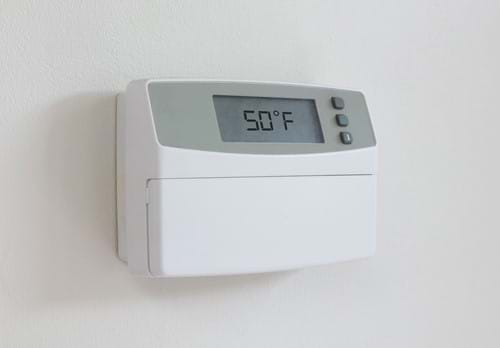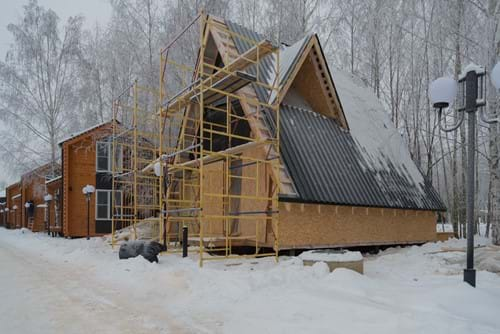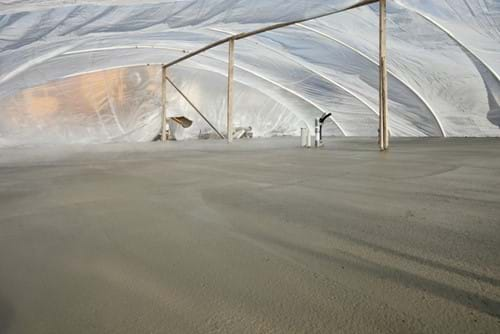Cold Weather Tiling Success
Install Tile Successfully in Cold Weather
Just three states maintain average temperatures above 50*F in the winter months. The widespread colder weather has a significant impact on tile installations throughout most of the U.S. and all of Canada. Besides the physical challenges of installing tile when temperatures dip, installers must manage the cold’s effect on building surfaces and materials. It becomes crucial to do extra planning, bring extra tools, take extra care and allow extra time, to make sure that cold weather tile installation is successful.

Before the Installation
Tile installations require ambient temperature to be 50-80°F. Installers should be flexible in scheduling to try to install tile when ambient temperatures are above 50ºF. However, it is possible to manage the implications of colder temperatures with good planning. Choose surface preparation and tile installation products that reduce risks from cold weather. Surface preparation products that provide waterproofing and crack isolation can protect the installation from damage due to moisture during installation and substrate movement from the cold. Fast set products reduce the cure time when installations are vulnerable to damage from fluctuating temperatures – which is especially important since cold weather lengthens cure times.
Installation materials manufacturers instruct that mortar and grout powders must be 50-80°F for use and for at least 24 hours prior to use. Make sure that all materials are stored at proper temperatures, as some installation materials are permanently damaged if they freeze. Consult the manufacturer’s freeze-thaw guidelines to ensure all products remain effective. The air, tile, water and substrate temperatures also must meet the 50-80°F installation guideline. The substrate’s temperature can be vastly different from the ambient temperature, when the job involves installing over, on, or below grade. When the work area needs to be warmed to 50°F+, tools such as temperature measuring devices, tenting and space heaters should be readily available. These tools keep the project on schedule and prevent material losses from freezing. Of course, follow all safety precautions when using portable heaters in cold weather.

During the Installation
Once the materials, substrate and job area are warmed to at least 50ºF, tile installation can begin. Given temperature changes throughout the day, installers must be vigilant in checking that ambient temperatures remain in compliance. Hygiene for the cold weather tile project takes on additional importance, since extra water or accidental product contamination can exacerbate already lengthened cure times. Be sure to clean and measure all materials with care.
Employing a waterproofing and crack isolation membrane offers a cold weather installation the additional benefit of protection from moisture and movement during the longer cure times. TEC HydraFlex™ Waterproofing Crack Isolation Membrane protects walls, floors and ceilings. The HydraFlex application stops in-plane cracks up to 1⁄4" (6 mm)* wide at the subfloor from telegraphing through to tile. In the cold or any temperature, the easy-to-see color change to purple lets the installer know when the HydraFlex membrane has cured.
Next, installers must ensure mortar, grout and water temperatures are between 50-80°F – lower temperatures will lead to an artificially long working time. If temperature is not controlled and the prepared mortar or grout is exposed to freezing temperatures, the water in the product will become ice crystals, interfering with the bond formation. This often leads to failure of the tile installation. Maintaining the proper 50-80°F working temperatures in cold climates prevents these failures.
Use of fast set products reduces cure time and the cold weather installation’s exposure to risks. TEC Fast Set 3N1® Performance Mortar is a quicker setting and lightweight premium mortar that combines polymer-modified, medium bed and non-sag features into one mortar, with 50 lbs. of coverage in a 30 lb. bag. In cold weather, allow additional time for the mortar’s curing and building of strength. Hold off on grouting for at least 72 hours, especially when the temperature is near 50°F. As with mortar, grout cure and strength building rates are extended in the cold. Fast-setting grout and stronger grout help to manage the extra challenges from cold weather. TEC Power Grout® has a unique, fast-setting formulation that is stain proof,** providing strong, color consistent joints free of efflorescence and resistant to shrinking or cracking. While Power Grout is ready for traffic in just 4 hours, waiting an additional few hours in cold weather is a wise precaution to protect the installation.
After the Installation
Once the tile installation is complete, make sure to protect it by covering it appropriately and continuing to warm the area to at least 50°F for a minimum of 2 days for fast set installation products and 7 days for other products. Taking the above actions, installers can rest assured that low temperatures will not jeopardize the success of the tile installation. Though cold weather installations require extra attention, time and effort; tile projects can continue successfully, building profitability year-round.

*Based on application
**Power Grout is stain proof to most common water based stains when cleaned immediately. Prolonged exposure to any stain will increase the likelihood of permanent staining or discoloration of grout surface.
